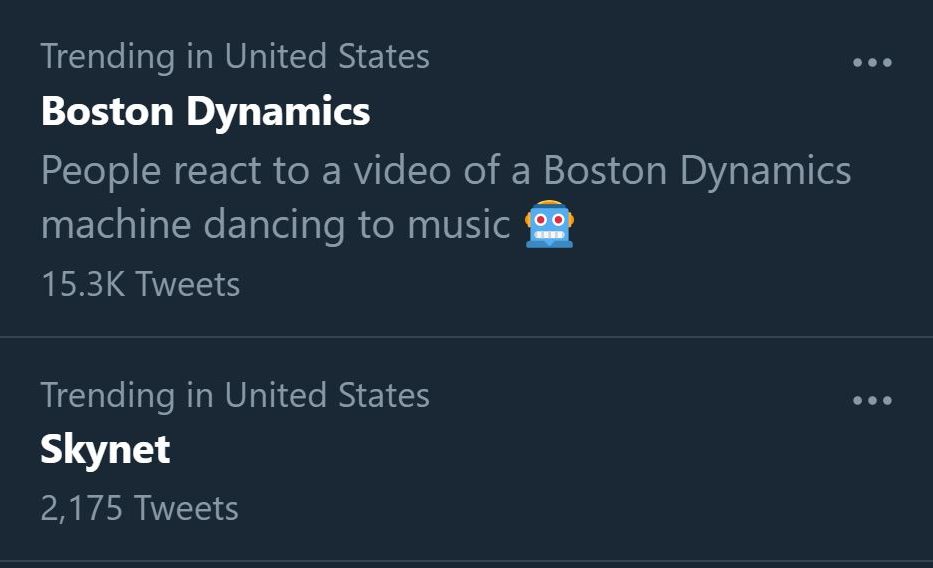Boston Dynamics machines flawlessly and soulfully dancing in rhythm. pic.twitter.com/1PHmurRo1k — Vala Afshar (@ValaAfshar) July 17, 2021 Why is this scary? I feel like I missed a memo. Did alien overlords come down and declare that all future combat would be settled via dance-offs between robots and humans over the weekend? Because, if that’s not what happened, the thousands of you freaking out over this are just being silly.
Sorry to crap on your “jokes,” everyone on Twitter, but every time Boston Dynamics teaches a robot to dance or do gymnastics you people tweet storm the same thing: oh no! It’s the end! And you don’t have to be an AI expert to understand that’s not the case. It’s as though these dance videos have subliminal messages that hypnotize the public into forgetting simple facts. Atlas, the robot in question, isn’t new. It’s been around since 2013 and Boston Dynamics regularly releases videos of it imitating human movements. In fact, the video people are reacting to is about a year old. As cool as Atlas is, its current claim to fame is that it… doesn’t fall down when it does things that humans can typically do. More importantly: we already have fully-autonomous killer robots. The difference between a Predator drone and Atlas-the-dancing-robot, is that the Predator drone can fly as fast as a jet and carries nearly 4,000lbs of munitions. [Read: Everything you need to know about the drone used by the US to assassinate an Iranian general] In all fairness though, I have no idea if the Predator can dab. The reason people fear Atlas but don’t get on Twitter every single day to shriek about the possibility of Predator drones attacking us is quite simple: drones don’t look like people so we trust them.
— Elon Musk (@elonmusk) November 26, 2017 Five years ago, this expert said “in a few years” these machines would move faster than the human eye can track. To date, it’s pretty much just gotten better at dancing. The only thing Atlas can do that a human can’t is take a few bullets without screaming “ouch.” It falls down just like people do, it’s not shock proof, it’s only as smart as it’s been trained to be, and it weighs less than 200lbs. You’re not mounting a rail gun on this thing, that’s for sure. In other words: it’s about as dangerous as a police officer or soldier. In a fight between Atlas and a Predator drone, the only way Atlas wins is if it breaks into the hangar while the Predator is charging. Honestly, a DJI drone hovering a meter above Atlas’ head with a bucket of oil could probably put the big bot on its butt. This isn’t a knock against Boston Dynamics, that’s just the way the physical universe works. Humans are not the ultimate physical killing machine. When it comes to making a murder bot, we’re a crappy base design to start with. We don’t fly, we’re among the slower predators on Earth, and our only real biological advantage is our brains. Check the video below to get a gander at what a real killer robot might look like in the near future: [Read: A beginner’s guide to the AI apocalypse: Killer robots] Using something like Atlas to subjugate humans doesn’t make a whole lot of sense unless you’re writing a science-fiction story and you need the humans in your tale to fight an enemy they can defeat with sticks and stones. It would be flat-out stupid for a billionaire, government, or even a sociopathic megalomaniac hellbent on world domination to roll out an army of robots that were almost as agile as a human. Sure, in 20 or 30 years Atlas will be stronger, faster, and more intelligent. But it still won’t be as well-suited for murdering humans as an autonomous tank, a drone, or a landmine. Rest-assured people, there are far more dangerous AI technologies for the general public to worry about than dancing robots. Could Atlas be used to hurt people? Absolutely. But it’s in no way, shape, or form an optimized killing machine.
